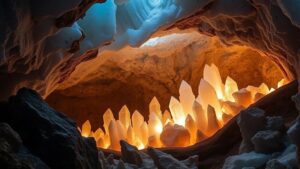Searching for rare red beryl in Utah’s Wah Wah Mountains, one of the rarest gemstones on Earth.
Searching for Rare Red Beryl in Utah’s Wah Wah Mountains
When it comes to gemstones, few possess the allure and rarity of red beryl, also known as bixbite. This precious mineral is celebrated not only for its stunning crimson hue but also for its scarcity; red beryl is estimated to be 1,000 times rarer than diamonds. For rockhounds and mineral collectors, the Wah Wah Mountains in Utah present a unique opportunity to seek out this elusive gem. In this article, we will explore the geological context, practical searching techniques, and collectible value of red beryl.
The Geological Context of Red Beryl
Red beryl is formed through specific geological processes that occur under unique conditions. It is a variety of beryl that includes traces of manganese, giving it its striking red color. The Wah Wah Mountains, located in Beaver County, Utah, provide an ideal environment for red beryl formation, characterized by volcanic activity and the presence of mineral-rich pockets within the rhyolitic rocks.
- Location: The primary site for red beryl mining is near the Knoll mine, which was discovered in the 1950s.
- Geological Features: The area consists of a complex of agate and beryl-bearing rhyolite, often associated with other gemstones like topaz and smoky quartz.
Understanding Rarity and Value
The exceptional rarity of red beryl is a key factor in its market value. It often sells for $10,000 to $30,000 per carat, depending on quality and size. For context, a well-cut red beryl can fetch prices comparable to fine rubies, but the market is much smaller due to the limited supply.
- Color Quality: The most desirable red beryl specimens exhibit a deep, vibrant red without any brownish undertones.
- Clarity: Eye-clean stones–those free from visible inclusions–are considerably more valuable.
Tips for Searching in the Wah Wah Mountains
If youre planning to hunt for red beryl in the Wah Wah Mountains, preparation is key. Here are some practical tips to increase your chances of success:
- Gear Up: Equip yourself with essential tools such as a rock hammer, chisel, safety goggles, and a backpack for collecting your finds.
- Research and Maps: Obtain geological maps of the region to identify known red beryl-bearing areas.
- Best Time to Search: Spring and fall offer optimal weather conditions; summer can be hot.
- Be Mindful of Regulations: Always check for any mining claims and obtain necessary permits before doing any digging.
Real-World Applications
Red beryl isn’t just a beautiful gemstone; it also finds applications in jewelry and investment-grade collections. Collectors often appreciate its rarity and distinctive properties, making it a worthwhile addition to any serious gem collection. Also, red beryl can serve as an educational tool, illustrating the importance of mineral formation processes and geological diversity.
Conclusion and Actionable Takeaways
Hunting for red beryl in the Wah Wah Mountains can be an exciting and rewarding pursuit for rockhounds and mineral collectors alike. By understanding the geological background, rarity, and proper searching techniques, enthusiasts can maximize their chances of finding this exquisite gemstone. To summarize:
- Prepare adequately with the right tools and knowledge of the area.
- Understand the value of red beryl and its market dynamics.
- Respect the environment and legal regulations while collecting.
With persistence and passion, you might just uncover a treasure that is not only visually stunning but also steeped in geological significance.



